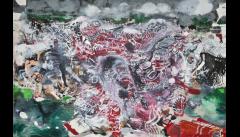Automobile Bavaria Group is delighted to introduce to the UK Romania’s leading artist and recipient of the UNESCO Gold Medal for outstanding contribution towards advancing the arts, Bogdan Lascar.
For Neuro-Epics Lascar will be showing nine works; five sculptures and four paintings, which form an arresting blend of the figurative and abstract, collage and fantasy. These works introduce to the UK the artist’s groundbreaking concept of “Neurophysiologic shapings”. The subject matter for both sculptures and paintings begin with forms including wild horses, human figures and elegant automobiles. These shapes are embedded in a blaze of colour, applied in semi-transparent layers of oil calling to mind a living ‘skin’ on the surface of the painting.
According to celebrated writer and art critic Edward Lucie-Smith,“Lascar seems to say some of the images we carry within ourselves are intricately entangled with our own physical being.”
Bogdan Lascar’s work is rooted in his background. Born in 1974 in Bacau, northern Romania, Lascar’s father was a doctor and his grandfather a sculptor, working mainly in wood - the young Lascar inherited many of his tools which he used in his early works.
After graduating from the Academy of Fine Arts in Bucharest, where he specialised in sculpture, Lascar went on to study medicine for three years at the University of Bucharest. This was not to affect a change of career but to “open another door” in the exploration of his art.
However, the biggest influence on his artistic approach was the Romanian revolution of 1989, when the dictator Nicolae Ceaucescu was toppled, ending 42 years of Communist rule. He was the last of the European Communist leaders to fall and the only one to be executed. Lascar was 15 at the time. “It had a great effect on my art,” he says. “I came to understand the shaping of society.”
The revolutionary fervour that erupted on to the streets of towns and cities all over Romania, and which Lascar experienced himself as an impressionable youngster, has informed his art in a very abstract, visual way. There are parallels between the shapings of society that he witnessed during those turbulent times, and the constant evolutionary changes taking part within the human body. Colour was an inescapable aspect too of the revolution, not only in the blood that was spilled but in the colourful mass protests. The colour of his pieces also reflect that of the human body’s interior and the colourful nature of society in general. Evolution was thus inspired by revolution.
Lucie-Smith writes:
“A striking phenomenon in the visual arts, since the fall of Soviet Communism and that of the satellite regimes allied to the Soviet sphere, has been the emergence of new kinds of avant-garde art, visibly allied to the creative impulses that manifested themselves in the early years of the 20th century, but also subtly different, sometimes with the kind of tragic resonance one senses here. The idea may, quite literally, be that certain kinds of creative originality have to be paid for in blood – and need to be celebrated by being framed in gold.”
Lascar’s work is held in numerous public and private collections internationally including the Museum of Art, Constanta, Romania and the National Museum of Contemporary Art, Bucharest, Romania.
Bogdan Lascar: Neuro-Epics
Saatchi Gallery, Duke of York's HQ, King's Road

Ad
Event has ended
This event ended on Sunday 3rd of May 2015
This event ended on Sunday 3rd of May 2015
Admission
Free
Free
Website
Tags:
Exhibition
User Reviews
There are no user reviews
